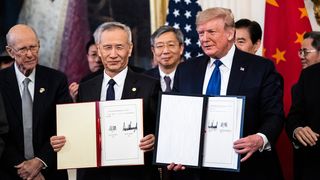After two years of negotiations, the US and China have signed a "phase one" economic and trade agreement that has forestalled further increases in US tariffs on imports from China. Equity markets rallied on the news, a measure of the extent to which the trade war has weighed on the global economic outlook.
While the stay on further tariff increases is welcome, US President Donald Trump has very little to show for his trade war, which has inflicted considerable damage on the US and world economies.
China has agreed to increase its purchases of US goods and services by $US200 billion over two years. If China follows through on this commitment, then US exports to China will grow by around 40 per cent in both 2020 and 2021, but these implied growth rates are difficult to believe.
Trump has told US farmers to buy more tractors, but with important details kept confidential, few US producers will be rushing to invest based on this agreement.
Given the delay in compiling trade statistics, we won’t know if China has met these commitments until well into the next presidential term.
To minimise the impact on commodity and other prices, the detail of the extra purchases is contained in a confidential annex.
Trump has told US farmers to buy more tractors, but with important details kept confidential, few US producers will be rushing to invest based on this agreement.
China has made commitments in a number of other areas, ranging from exchange rate management and technology transfer to protection of intellectual property and market access for foreign firms.
The commitments on intellectual property are substantial, not unlike those seen in other major trade deals such as the US-Mexico-Canada agreement. They partly reflect China’s existing efforts to improve its domestic law. It is in China’s interests to make these changes, but they will require significant legal and judicial reform in China to be properly enforced.
Many of the other commitments simply reiterate existing obligations under China’s World Trade Organisation accession protocol or reflect steps China is already taking to improve the regulation of its economy.
A key issue will be how the US will monitor and enforce China’s compliance with the terms of the agreement.
Despite the name on the front page, the deal is not a trade agreement in the usual sense of an international treaty that has been legislated domestically by the parties.
The deal represents the best the Trump administration could realistically salvage from a trade war of its own making ahead of this year’s presidential election.
It is more a memorandum of understanding between executives in the US and China. It has no effective standing in US domestic law. Because it is arguably inconsistent with WTO obligations, in particular the principle of non-discrimination, the deal has no standing in international law either.
In legal terms, the deal is not much more than a 94-page press release.
Although it includes dispute resolution provisions, these amount to little more than a commitment to talk through disputes. There is no provision for independent or impartial monitoring or enforcement.
It is likely the US and China will come to disagree on whether the terms of the agreement are being met. If there is a dispute that cannot be resolved, parties can agree to proportional retaliation (most likely increased tariffs), or they can walk away from the deal in its entirety.
The deal represents the best the Trump administration could realistically salvage from a trade war of its own making ahead of this year’s presidential election.
A full-fledged trade agreement between the US and China that was consistent with their WTO obligations and, legislated domestically, would take many years to negotiate. For instance, the negotiations over China’s WTO accession protocol took 15 years.
Trump will no doubt talk up the deal, but from an economic point of view its provisions are of limited significance. It leaves in place an average tariff rate on Chinese imports to the US of about 20 per cent, a tax increase that has already imposed a heavy burden on US businesses and consumers.
It will help get US producers off federal welfare following a slump in exports to China. Ironically, it will make US producers even more dependent on China and more vulnerable to future outbreaks of trade tensions.
The deal’s main economic benefit is to prevent what would have been a further increase in US tariffs. But the US never needed an agreement with China to avoid shooting itself in the foot with more tariffs.
Having taken two years to negotiate a minimalist phase one deal, a phase two agreement is likely to prove even more elusive. While the US has offered further tariff reductions as an incentive and may once again threaten more tariffs, China will be happy enough to play for time and string out any new trade talks.
Overall, with little substance in law or economics, the agreement exemplifies the failure of Trump’s protectionist trade diplomacy.






